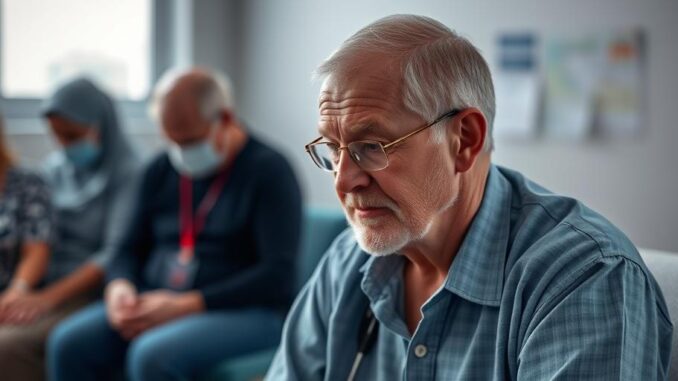
Summary
A recent study reveals a concerning trend: more stroke patients are dying at home than ever before. This shift raises questions about access to care, especially for rural and minority populations. The study also found an overall increase in stroke mortality rates after years of decline.
** Main Story**
Okay, so a new study just came out in PLOS One, and honestly, it’s pretty alarming. It looks at ischemic stroke mortality in the US, and what it’s found is a worrying jump in the number of people dying at home from these strokes. In fact, the at-home deaths have actually overtaken the number of deaths happening in hospitals. And that’s not good, right? I mean, it really raises questions about whether people are getting the care they need, especially those who are already vulnerable.
Where People Are Dying is Shifting
Researchers at Georgetown University School of Medicine dug into data going all the way back to 1999, right up to 2020. We’re talking about 237,617 stroke deaths they looked at. The picture that emerges isn’t pretty. Back in ’99, only about 8.44% of ischemic stroke deaths happened at home. Fast forward to 2020, and that figure had skyrocketed to 29.31%. On the flip side, the percentage of deaths in hospitals – inpatient services – dropped from 46.41% to 29.56% during the same period.
What’s really concerning is that this means a lot of people simply aren’t getting the medical attention they desperately need when they’re having a stroke. Stroke is a real emergency! It demands swift action, and, well, if you’re not in a hospital, that action isn’t going to happen quickly enough. The consequences for patients can be dire. You know, I remember hearing about a neighbor of my grandmother’s who had a stroke at home. By the time the ambulance arrived, it was just too late. That’s the kind of situation this study highlights.
Access to Care: Who’s Missing Out?
But there’s more to the story, the study also uncovers some pretty significant disparities in who gets access to good end-of-life stroke care. It turns out people in rural areas, and Black Americans, are much more likely to die in settings that aren’t as specialized. Think about it, people living in cities, white people, they’re statistically more likely to get access to the specialized care that could make a difference. This isn’t just bad luck; it points to systemic issues, right?
For example, rural areas often lack hospitals and specialized medical centers. Then, sadly, racial minorities often face all sorts of barriers getting equitable care. It’s a complicated problem, no doubt about it.
Stroke Mortality is Creeping Up
To make matters worse, the study also shows that after a decade of declines, overall age-adjusted ischemic stroke mortality rates? They’ve been increasing across all levels of urbanization since 2009. And guess where the rise is most significant? You guessed it; non-metropolitan areas. It’s as if all the progress we’ve made in stroke prevention and treatment is starting to unravel, and that really is a problem.
Why is this happening? Well, there are theories. Could it be that things like obesity and diabetes are becoming more common? Is it that we’ve hit a plateau in controlling things like cholesterol and blood pressure? Maybe it’s a combination of factors. Either way, something is clearly going wrong.
What About Geriatric Care?
So, what can we do about all this? For one thing, the findings really emphasize the need to really boost geriatric care, to get a handle on these rising stroke deaths and the uneven access to treatment. Think about it: innovations in technology. Things like remote monitoring, telehealth, smart home systems… they could be game-changers! They could help bridge the gap between older folks and healthcare providers. Continuous monitoring, virtual check-ins, quicker interventions… these things can seriously improve outcomes, especially for stroke patients in those underserved areas.
It’s Time to Act
Look, this increase in stroke deaths at home? It’s not just a statistic; it’s a clear signal that something is broken. Our healthcare systems and policymakers need to wake up and address what’s happening, which I think, is easier said than done. We need to tackle the root causes: the disparities in healthcare access, the overall increase in stroke mortality, and the need for much better geriatric care models. Investing in new technology, expanding access to specialized care in rural communities, and getting rid of systemic barriers that prevent racial minorities from getting the care they deserve, well, we can, and should improve the lives of stroke patients across the country. It requires more research and exploration into the epidemiological, infrastructural, health policy, and access-related factors driving disparities nationwide. What do you think, are we up to the task?


Home is where the heart is, but apparently not necessarily where the stroke care is. Telehealth sounds great, but does anyone have a failsafe for when grandma inevitably forgets how to unmute?
That’s a great point about the challenges of telehealth! We definitely need user-friendly solutions for everyone, especially when quick action is critical. Perhaps simplified interfaces or dedicated support lines could help bridge the digital gap. What other ideas do you have?
Editor: MedTechNews.Uk
Thank you to our Sponsor Esdebe
The increasing stroke mortality in non-metropolitan areas is concerning. Could the rise be linked to the closure of rural hospitals and the resulting longer EMS transport times to specialized stroke centers? Further investigation into this correlation seems critical.